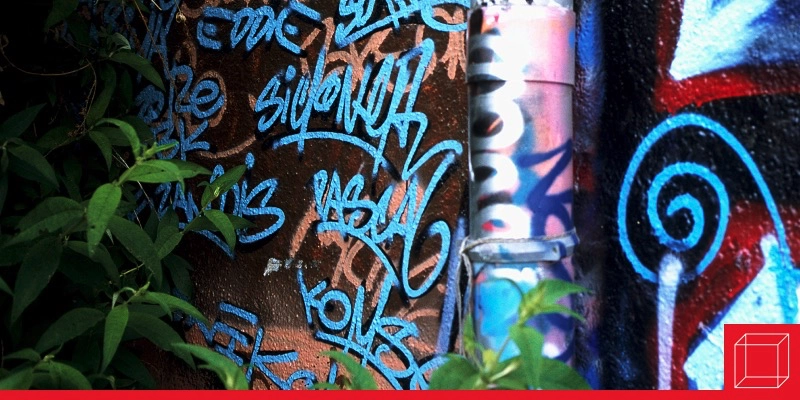Graffiti – Who Owns It?
When art is placed on buildings or other structures, the question of ownership becomes complicated.

There is no definite date to when graffiti was invented, but we do know that it has been around since humans have had the ability to leave their mark. In recent decades, some graffiti works have transcended the label of vandalism and have been labeled as museum-quality art. The term graffiti is often interchanged with “street art” and “graffiti art.” When the works are created on traditional art materials or are easily traded objects, there’s no question as to who owns them before they are sold. But when the art is placed on buildings or other structures, the question of ownership is more complicated.
The now-demolished graffiti site 5Pointz in Queens, New York, brought attention to the issue faced by graffiti artists whose works are destroyed without notice. Although most graffiti artists paint with the expectation that their works can be covered up without notice, 5Pointz was in a unique position because the owner gave the artists access. He even worked with one of the artists, Jonathan “Meres” Cohen, to act as curator of the works appearing on the buildings. Several artists sued the owner under the Visual Artists Right Act of 1990 when they discovered that 5Pointz was going to be demolished to make way for luxury apartment buildings. Although they won their case, the owner whitewashed the buildings before artists could properly remove or document their works. Many of the works by dead or retired artists were lost to what some would consider corporate greed.
Bansky, a well-known graffiti artist in the United Kingdom, places most of his works on buildings without permission, just like traditional graffiti tags. Unlike traditional graffiti, these works are highly sought after. There have been instances where owners of the buildings have professionally removed large chunks of wall to profit from these free artworks that were meant for public viewing. By removing the works, the owners dampen the impact and, sometimes, the humor the artist intended to convey. Other owners have knowingly or unknowingly painted over or removed Banksy’s works. Reasons for removal range from not knowing who created the work to simply considering it vandalism. Owners who wish to remove a Bansky are often encouraged to donate it, but many are able to find someone willing to buy the piece without official documentation from the artist other than a social media post claiming the work.
These are just a couple of recent examples where the question or responsibility of ownership comes into play. There are many other instances in which artists create free murals or public works only to have the works auctioned off or destroyed. Where does ownership lie in situations such as these? What rights do artists have when they receive no compensation for works that are removed from public spaces and sold? There are no clear answers to questions like these, but it is important to ask them and consider answers for them to prevent future issues like 5Pointz.
Questions for Discussion
Research the court case of 5Pointz in New York City. How should ownership be determined in a case such as this? What responsibility should an owner have when they are working with artists? What responsibility do artists have when working with building owners?
Is it ethical for building owners to remove works by artists like Bansky and profit from the “free” works? Should artists be compensated? Why or why not?
Travel around your local area or a place you frequent. Document where you see graffiti, murals, or other types of public art. Where is the work located? Who created the piece? Who owns the work? Discuss how you determined your answers.
Blakemore, Erin. “Graffiti Grudge Goes to Federal Court.” Smithsonian.com, Smithsonian Institution, 11 Apr. 2017, https://www.smithsonianmag.com/smart-news/graffiti-grudge-goes-federal-court-180962846/.
Frishberg, Hannah. “Banksy Art Ripped out of Building Wall by UK Landlord.” New York Post, New York Post, 17 Nov. 2021, https://nypost.com/2021/11/16/banksy-art-ripped-out-of-building-wall-by-uk-landlord/.
Gilbert, Laura. “A Law Meant to Protect American Artworks from Destruction Is Failing.” Artsy, 29 Sept. 2015, https://www.artsy.net/article/artsy-editorial-why-the-visual-artists-rights-act-is-failing-to-protect-street-art-and-murals.
Kinsella, Eileen. “A Stunning Legal Decision Just Upheld a $6.75 Million Victory for the Street Artists Whose Works Were Destroyed at 5Pointz.” Artnet News, Artnet News, 21 Feb. 2020, https://news.artnet.com/art-world/5pointz-ruling-upheld-1782396.
Liscia, Valentina Di. “Before and after Photographs of 5Pointz Mural Site Show a Bleak Transformation.” Hyperallergic, 29 Apr. 2021, https://hyperallergic.com/632795/before-and-after-photographs-of-5pointz-mural-site-show-a-bleak-transformation/.




